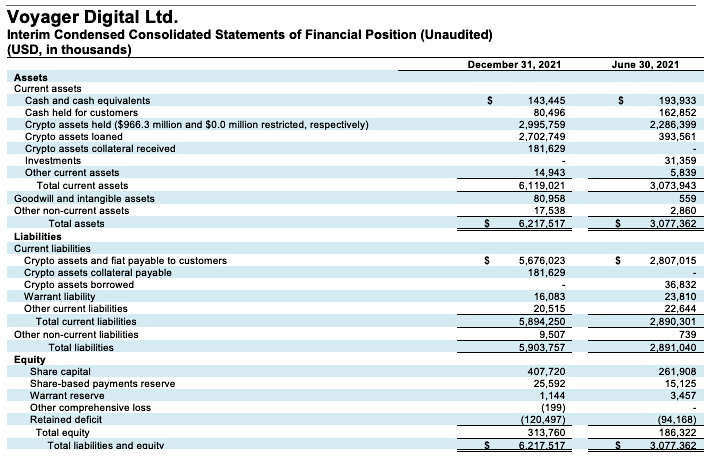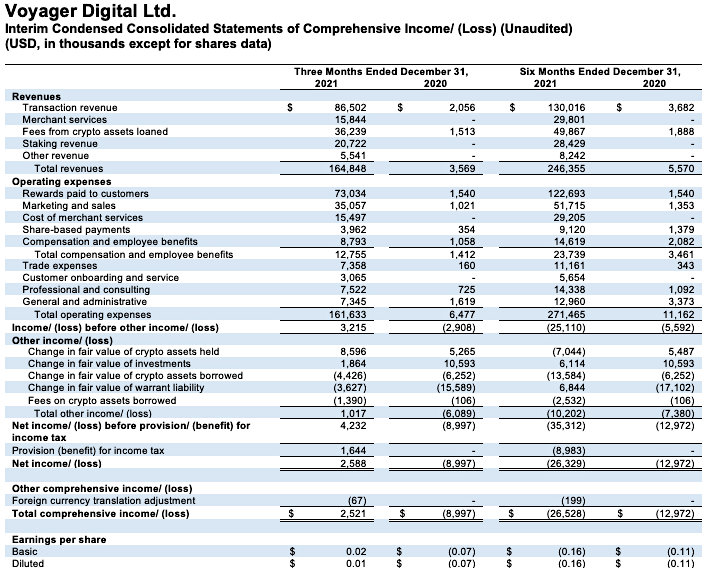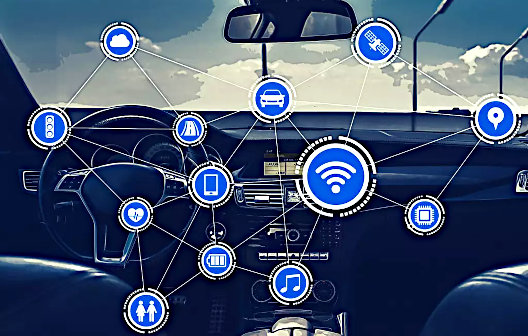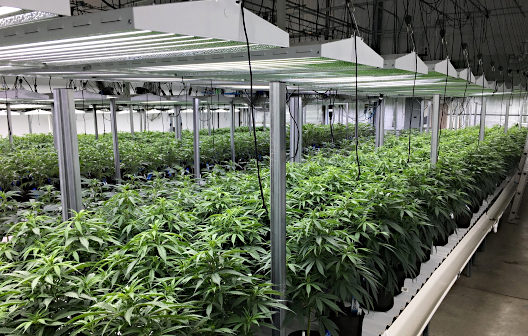
Voyager Digital Reports Revenue of US$164.8 Million for the Quarter Ended December 31, 2021
Research, News, and Market Data on Voyager Digital
Voyager Digital Ltd. (“Voyager” or the “Company”) (TSX: VOYG; OTCQX: VYGVF; FRA: UCD2) one of the fastest-growing, publicly traded cryptocurrency platforms in the United States, today announced revenue and user metrics for the Fiscal 2022 Second Quarter ended December 31, 2021.
“I am excited to report our best quarter ever, doubling our revenue from the previous quarter, and highlighting Voyager’s positioning and revenue opportunity in active markets,” said Steve Ehrlich, CEO and Co-founder of Voyager. Ehrlich continued, “More importantly, we delivered significant revenue growth and supported a marked increase in customer activity without any material system issues during the quarter, highlighting the steps we’ve taken to build out the scale and security of the Voyager platform in 2021, as we position Voyager for a series of product roll outs in calendar 2022.
“We are a product delivery organization and are taking the necessary steps to continue our revenue diversification strategy,” continued Mr. Ehrlich. “The launch of our Voyager Debit Card, which allows for payroll direct deposits, is the next step in revenue diversification. We recently added engineering resources to our team which allowed us to add more tokens to the trading platform, and tokens available for staking. By the end of the March quarter, we expect our desktop platform and dark mode will be added to our product offering. We are also building towards adding equities to the platform, expanding the platform to Europe and Canada, and offering an NFT product and wallet. All of these are significant opportunities for the Company; and with our NFT platform we intend to make the viewing, acquiring and custody of NFTs easy for consumers.”
The Company is pleased to announce the following Fiscal 2022 Second Quarter ended December 31, 2021 Financial and Operational Key Metrics:
- Revenue for the quarter is $164.8 million with $149.0 million for the historical business and $15.8 million from the Coinify merchant business. The $164.8 million in revenue is up over 4400% compared to $3.5 million for the quarter ended December 31, 2020.
- Revenue for the calendar year ended December 31, 2021 is $415.8 million vs $6.6 million for the calendar year ended December 31, 2020.
- Adjusted EBITDA is $17.4 million for the quarter vs $2.8 million for the quarter ended December 31, 2020.
- Operating Income is $3.2 million for the quarter vs a loss of $2.9 million for the quarter ended December 31, 2020.
- Total verified users on the platform stand at more than 3.2 million, up 49% from 2.15 million at the quarter ended September 30, 2021.
- Total funded accounts exceed 1,074,000 as of December 31, 2021, up 25% from 860,000 at the quarter ended September 30, 2021.
- Total Assets on Platform grew to $5.9 billion from $4.3 billion at September 30, 2021.
- Our headcount increased to 250 as of December 31, 2021, from 231 at September 30, 2021.
All figures are preliminary and unaudited and subject to final adjustment. All amounts are in U.S. dollars, unless otherwise indicated.
“I am truly excited about where we are and where we are going. Voyager’s business continues to grow every day and the company is well positioned as a pioneer in the digital asset space,” Ehrlich added.
Conference Call Details
Voyager will discuss its Fiscal 2022 Second Quarter results today, February 15, 2022, via a conference call at 8:00 a.m. Eastern Time. To access the webcast, please register by clicking here. A live webcast and a replay will be available on the Investor Relations section of the Company’s website at https://www.investvoyager.com/investorrelations/overview.
About Voyager Digital Ltd.
Publicly traded Voyager Digital Ltd.’s (TSX: VOYG) (OTCQX: VYGVF) (FRA: UCD2) US subsidiary, Voyager Digital, LLC, is a fast-growing, cryptocurrency platform in the United States founded in 2018 to bring choice, transparency, and cost efficiency to the marketplace. Voyager offers a secure way to trade over 85 different cryptocurrency assets using its easy-to-use mobile application and earn rewards up to 12% annually on more than 35 cryptocurrencies. Through its subsidiary Coinify ApS, Voyager provides cryptocurrency payment solutions for both consumers and merchants around the globe. To learn more about the company, please visit https://www.investvoyager.com.
The TSX has not approved or disapproved of the information contained herein.
Forward Looking Statements
Certain information in this press release, including, but not limited to, statements regarding future growth and performance of the business, momentum in the businesses, future adoption of digital assets, and the Company‘s anticipated results may constitute forward looking information (collectively, forward-looking statements), which can be identified by the use of terms such as “may,” “will,” “should,” “expect,” “anticipate,” “project,” “estimate,” “intend,” “continue” or “believe” (or the negatives) or other similar variations. Forward-looking statements involve known and unknown risks, uncertainties and other factors that may cause Voyager’s actual results, performance or achievements to be materially different from any of its future results, performance or achievements expressed or implied by forward-looking statements. Moreover, we operate in a very competitive and rapidly changing environment. New risks emerge from time to time. It is not possible for our management to predict all risks, nor can we assess the impact of all factors on our business or the extent to which any factor, or combination of factors, may cause actual results to differ materially from those contained in any forward-looking statements we may make. In light of these risks, uncertainties, and assumptions, the future events and trends discussed in this press release may not occur and actual results could differ materially and adversely from those anticipated or implied in the forward-looking statements. Forward looking statements are subject to the risk that the global economy, industry, or the Company’s businesses and investments do not perform as anticipated, that revenue or expenses estimates may not be met or may be materially less or more than those anticipated, that trading momentum does not continue or the demand for trading solutions declines, customer acquisition does not increase as planned, product and international expansion do not occur as planned, risks of compliance with laws and regulations that currently apply or become applicable to the business or the interpretation or application of laws and regulations by regulatory authorities, and those other risks contained in the Company’s public filings, including in its Management Discussion and Analysis and its Annual Information Form (AIF). Factors that could cause actual results of the Company and its businesses to differ materially from those described in such forward-looking statements include, but are not limited to, a decline in the digital asset market or general economic conditions; changes in laws or approaches to regulation, regulatory investigations, enforcement actions or other regulatory action or sanction, the failure or delay in the adoption of digital assets and the blockchain ecosystem by institutions; changes in the volatility of crypto currency, changes in demand for Bitcoin and Ethereum, changes in the status or classification of cryptocurrency assets, cybersecurity breaches, a delay or failure in developing infrastructure for the trading businesses or achieving mandates and gaining traction; failure to grow assets under management, an adverse development with respect to an issuer or party to the transaction or failure to obtain a required regulatory approval. In connection with the forward-looking statements contained in this press release, the Company has made assumptions that no significant events occur outside of the Company’s normal course of business and that current trends in respect of digital assets continue. Readers are cautioned that the key metrics disclosed in this press release, including, without limitation, Assets Under Management and trading volumes fluctuate and may increase and decrease from time to time and that such fluctuations are beyond the Company’s control. Forward-looking statements, past and present performance and trends are not guarantees of future performance, accordingly, you should not put undue reliance on forward-looking statements, current or past performance, or current or past trends. Information identifying assumptions, risks, and uncertainties relating to the Company are contained in its filings with the Canadian securities regulators available at www.sedar.com. The forward-looking statements in this press release are applicable only as of the date of this release or as of the date specified in the relevant forward-looking statement and the Company undertakes no obligation to update any forward-looking statement to reflect events or circumstances after that date or to reflect the occurrence of unanticipated events. The Company assumes no obligation to provide operational updates, except as required by law. If the Company does update one or more forward-looking statements, no inference should be drawn that it will make additional updates with respect to those or other forward-looking statements, unless required by law. Readers are cautioned that past performance is not indicative of future performance and current trends in the business and demand for digital assets may not continue and readers should not put undue reliance on past performance and current trends. Refer to definition of certain Non-IFRS terms in Management’s Discussion and Analysis including Assets On Platform, Adjusted EBITDA and Adjusted Working Capital. All figures are in U.S. dollars unless otherwise noted.
SOURCE Voyager Digital, Ltd.
Press Contacts
Voyager Digital, Ltd.
Michael Legg
Chief Communications Officer
(212) 547-8807
mlegg@investvoyager.com
Voyager Public Relations Team
pr@investvoyager.com


























